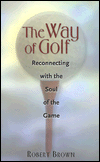The Way of Golf: Reconnecting with the Soul of the Game
Nowadays, people don’t often make extended and persuasive arguments on important issues.
I blame television.
Modern TV programming tends to emphasize heat over light, sound bites over reflective discussion. It’s not just Jerry Springer’s show, either. For example, compare a typical current events broadcast of Chris Mathews’ Hardball on MSNBC, with William F. Buckley’s old Firing Line debates.
I like Hardball, but I’m also well aware of its limitations.
Readers who feel the same way will welcome Robert Brown’s new book, The Way of Golf: Reconnecting with the Soul of the Game, (Burford Books, $20 SRP).
Brown doesn’t mind taking the time to flesh out his thoughts, and the results are both convincing and well worth it.
Brown is the Director of a non-profit golf foundation called Keepers of the Game. The organization’s mission is to uphold the better parts of golf’s traditions and values. As Brown shows with cogent examples, they have their work cut out for them.
In this series of essays extending just over 200 pages, Brown describes what those traditions are; why they are important to the game and its players; how they are under assault; and what can be done about it.
For example, golfers are reminded to “play the course as you find it.” Against that time-honored tradition stands the trend toward insisting upon perfect turf, not only in the fairway, but also in what is euphemistically called “rough.” Perfection in maintenance practices usually results in lovely views, but at the cost of reducing an appreciation for the more natural environment in which the game once flourished.
Brown discusses the importance of golf’s rules, and not merely those established by the USGA or the Royal and Ancient Golf Club of St. Andrews. These include politeness and consideration for others, honor, respect for the course, and discipline.
In one pithy segment, Brown explains how to properly assess the “fairness” of golf:
Golf fits every definition of fairness in the dictionary if you define the term from the game’s point of view and not the player’s. The rules are as clear as human thought can make them, and they’re critically evaluated continually and changed as needed. The course sits and waits, visible to the eyes and further defined by pars, ratings, yardage, and slope. Natural elements like wind and sun are as unbiased as anything can be. The ball goes where you hit it and waits until you’re ready to hit it again. Nothing could be fairer than golf—except in its choice of adversaries. Golf seems to be an unfair game because it pits you against yourself; an impossibly difficult opponent.
Brown’s essays cover the entire range of potential topics, including equipment, course management, handicapping, and professionals. Part 5 of the book is devoted to the golf swing, however, and it’s hard to see how it fits in with the other seven segments. Most of the book essentially stresses issues concerning honor, tradition, values, and standards. The segments on the golf swing provide good basic information, but the essentially moral emphasis stressed in the other essays makes this part jarring in comparison.
Fortunately, Brown returns to his basic themes for the remainder of the book. He enlists the help of useful quotations from several sources, some of whom would be surprised to find themselves cited in these essays. Any writer who can find and use appropriate material from Herbert Warren Wind and Arlo Guthrie has a nice command of his argument.
Despite the disturbing trends he describes and critiques, Brown remains warily optimistic. He recognizes the role that golfers who are serious about maintaining the core elements of the game can play in preserving golf. This book should help these players convince others to help protect their favorite sport.
Review Date: July 13, 2001


